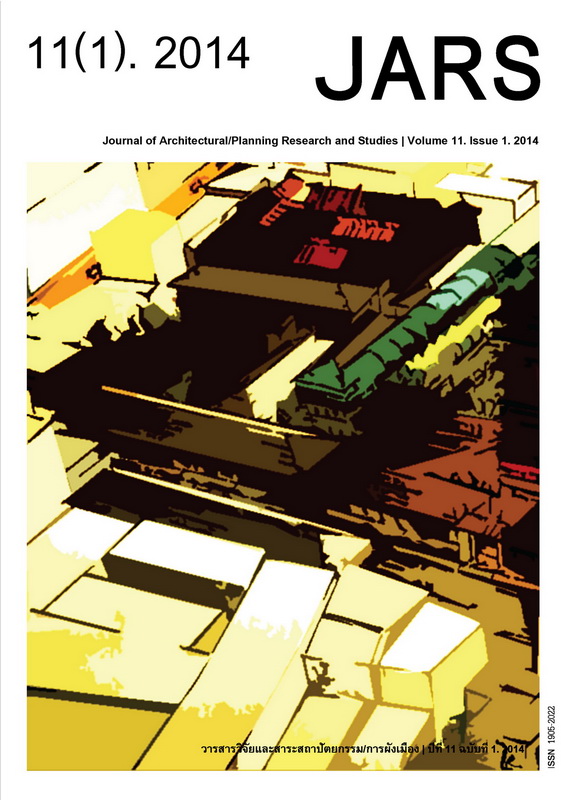Assessment of Overall Thermal Transfer Value (OTTV) in Buildings with Inclined Glass Wall
Main Article Content
Abstract
The Ministry of Energy of Thailand promulgated the criteria for computing the Overall Thermal Transfer Values (OTTV) to manage building energy efficiency in 1992. These criteria were improved in 2009 to cover dissimilar heat transfer rates in the daytime and the nighttime for offices, stores and hotels constructed with 0 to 90-degree roofs and walls. However, the assessment of OTTV of buildings with wall inclinations greater than 90 degrees has been excluded with only approximate values being used in the calculation. The objective of this paper, therefore, is to propose a calculation method of Effective Solar Radiation (ESR), a variable in OTTV equation, for office buildings with 105-150 degree wall inclinations, taking into account the effects of ground reflectance values of 0.05, 0.2 and 0.32 for water, grass, and white concrete, respectively. The ESR values for the inclined glass wall were obtained from the slope of linear relationship between the simulated solar heat gain and the glass’s Solar Heat Gain Coefficient (SHGC). The simulated results and the regression analysis showed that the derived ESR values of the vertical wall were compatible with the ESR values in the building energy code (BEC) and the energy used index, similar to that obtained from energy audits. The ESR values decreased by 2.7-37% as the glass wall inclination increased, resulting in a decrease of the OTTV by 2.0-17%. For the high ground reflectance of 0.32 and SHGC of 0.54, the results showed that the OTTVs of the building with inclined walls exceeded 50 W/m2. Therefore, grass and water are recommended for the landscape around energy efficient buildings.
Downloads
Article Details

This work is licensed under a Creative Commons Attribution-NonCommercial-NoDerivatives 4.0 International License.
All material is licensed under the terms of the Creative Commons Attribution 4.0 International (CC-BY-NC-ND 4.0) License, unless otherwise stated. As such, authors are free to share, copy, and redistribute the material in any medium or format. The authors must give appropriate credit, provide a link to the license, and indicate if changes were made. The authors may do so in any reasonable manner, but not in any way that suggests the licensor endorses you or your use. The authors may not use the material for commercial purposes. If the authors remix, transform, or build upon the material, they may not distribute the modified material, unless permission is obtained from JARS. Final, accepted versions of the paper may be posted on third party repositories, provided appropriate acknowledgement to the original source is clearly noted.
References
Asavapitayanont, A. (2010). Energy conservation performance in building with tilted envelope in hot humid climate [Unpublished]. Master Thesis, Faculty of Architecture and Planning, Thammasat University, Bangkok, Thailand.
Chan, A. L. S., & Chow, T. T. (2014). Thermal performance of air conditioned office building constructed with inclined walls in different climates in China. Applied Energy, 114, 45-57.
Chirarattananon, S., Chaiwiwatworakul, P., Hien, V.D., Rakkwamsuk, P., & Kubaha, K. (2010). Assessment of energy savings from the revised building energy code of Thailand. Energy, 35(4), 1741-1753.
Chirarattananon, S., & Taveekun, J. (2004). An OTTV-based energy estimation model for commercial buildings in Thailand. Energy and Buildings, 36(7), 680-89.
Chou, S. K., & Chang, W. L. (1996). A generalized methodology for determining the total heat gain through building envelopes. International Journal of Energy Research, 20(10), 887-901.
Chow, W. K., & Chan, K. T. (1995). Parameterization study of the overall thermal-transfer value equation for buildings. Applied Energy, 50(3), 247-268.
Chungloo, S. Limmeechokchai, B., & Chungpaibulpatana, S. (2001). Parametric analysis of energy efficient building envelope in Thailand. Asian Journal of Energy and Environment, 2(2), 125-143.
Department for Alternative Energy Development and Energy Efficiency [DEDE]. (2007). Ministry of energy, the royal government of Thailand, Manual of building energy conservation standard. (In Thai). Bangkok: Author.
Horayangura, V. (2011). The creation of cultural heritage towards the development of a modern Thai architectural identity. Journal of Architectural/Planning Research and Studies, 8(1), 1-19.
Nikpour, M., Kandar, M. Z., Ghasemi, M., Ghomeshi, M., & Safizadeh, M. R. (2012). Heat transfer reduction using self shading strategy in energy commission building in Malaysia. Journal of Applied Sciences, 12(9), 897-901.
Srivanich, M., & Hukao, K. (2012). Thermal infrared remote sensing for urban climate and environmental studies: An application for the city of Bangkok, Thailand. Journal of Architectural/Planning Research and Studies, 9(1), 83-100.


